Not So Far Away
POSTED ON: April 2, 2015
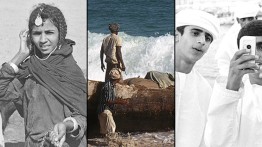
From "Three Views of Oman." For a photo gallery see at the bottom of the article.
Three Views of Oman, an internationally traveled exhibition of photographs documenting the history, culture and environs of an ancient land little known outside of Arabia, has made its U.S. debut in the Arthur A. Houghton Jr. Gallery, where it will remain on view until April 25. The organizers took us on a tour.
Co-sponsored by The Irwin S. Chanin School of Architecture, along with the Ministry of Awqaf and Religious Affairs of the Sultanate of Oman and the Institute for American Values, it represents an unusual collaboration between a school of architecture, a foreign government and a civics-focused think tank. Subtitled "The Photography of Wilfred Thesiger, Charles Butt and Edward Grazda 1945-2006," it serves all three institutions by offering viewers the chance to appreciate striking images of a developing country through its people, its rapidly changing built spaces and the emergence of a country through organized governance.
"Students in the School of Architecture will find themselves increasingly charged with making places of meaning in the civic, cultural and spiritual realms for people who have a history and culture that may be different than theirs," says Elizabeth O'Donnell, acting dean of the school. "Before we can be effective architects, we must first be expert observers, aware of our own cultural biases. Here we may turn to the arts, perhaps to the example of the three photographers of Oman."
Raina Sacks Blankenhorn, curator of the exhibition and editor of its companion book, took us on a tour of the gallery. [See below for large-scale versions of the images discussed.] "I chose pictures that I thought were arresting and beautiful to look at," she says. "But what I also love about a photograph is that it allows you to think and to breath and gives you space. You don't know everything that's going on in a photograph, especially in historical images. And for me that's what makes this a platform to have an exchange with another culture."
The works on display form a visual history of Oman's rapid emergence from warring tribal factions to oil-rich sultanate in just 70 years. The earliest works, by Wilfred Thesiger, a roving adventurer and amateur photographer, capture the denizens of the "empty quarter,” at the western edge of the Sahara. The black and white images from the mid- to late-1940s evoke the desert heat and lifestyle through portraits of tribesmen and women as they pose for the camera, looking straight at you amidst sand, rocks and scrub brush.
"Thesiger’s travel across the Rub al Khali in the 1940s was as arduous as it was unusual for its time," Ms. Sacks Blankenhorn says. She stops in front of a photo of a young man, identified as Salim bin Kabina, who faces the camera wearing a white dishdasha and traditional khanjar, the short curved sword, in his belt. Behind him stretches the dry, flat desert. "For this exhibition I focused on his images of people because his personal and emotional connection with his Bedouin companions is so evident. He points and shoots and they stare right back. Thesiger and bin Kabina, for example, remained friends throughout their lives."
"I love this picture of the woman at the well," Ms. Sacks Blankenhorn says, pointing to another Thesinger work. In it a young woman pulls on a rope at a well in the desert. She addresses the camera as she tucks a strand of hair behind her ear, challenging Thesiger’s gaze. A shirtless man behind her looks off to the side. They are clearly working together. "I doubt you would see that now, as life in the desert has changed so completely. Now there are roads, running water, and Omanis are looking forward to high-speed trains that will cross the desert and connect all of Arabia."
In the center of the gallery space hang color images of Oman's national foment -- it was established only in 1970 -- captured through the lens of Charles Butt, a member of the British Intelligence Corps and prolific amateur photographer. Traveling by helicopter and jeep, Butt took photos over 12 years, beginning in the mid-1960s, as Oman tapped into its oil reserves and began a rapid period of development. In one notable image, a Shell Oil sign stands outside the main gate of the city of Muttrah.
"Charles Butt sees the world from an entirely different perspective than Thesiger," Ms. Sacks Blankenhorn says. "He was there at a very critical time. You can see the country coming together in his photographs." Some images capture key personalities such as Sultan Qaboos bin Said al-Said, Oman's founder, working with other Arab leaders. But American viewers may be more struck by the large number of coastal shots. Oman sits on the Gulf of Oman and the Arabian Sea, and Butt captures life by the sea as well as other lush, verdant parts of the countryside. His pictures of ordinary people selling mangos from boats or threshing a harvest make the most human connection.
Besides offering the viewer a visual history of a country, "Three Views of Oman" also provides a microcosm of the way photojournalism and the Western observation of "the other" changes over the course of the past 50 years. The contemporary photos by the third featured photographer, Ed Grazda, have a very different viewpoint than the other two.
"Ed Grazda is looking for that decisive, caught moment. He's an observer, a professional documentary photographer who is very much aware of himself as someone looking at another culture. Where Thesiger is in emotional relationships, Grazda wants to keep his distance. Ed Grazda’s angles force the viewer to connect with Omani culture from entirely different perspective."
Ms. Sacks Blankenhorn has an example of Grazda's work that she finds particularly meaningful. Viewed from above, a couple stand alone in the aisle of a pristine supermarket, otherwise empty of people but with rows of goods in perfectly fronted presentations. "I think this is iconic. It's definitely an arresting view. You see modernization coming at this couple. Of course, I am choosing to put this interpretation on it. They're just standing there. But between his angle and what you know is going on the world, there are many challenges facing this couple, facing in opposite directions, and the image instantly challenges the viewer to engage with the same concerns."
The organizers hope visitors to "Three Views of Oman" will walk away with more than just an aesthetic experience. "I hope they will see the responsiveness in the people of Oman, their humanity," says Ms. Sacks Blankenhorn. "I would want them to see that there is a possibility of creating relationships. And that people should take that step to get to know a place and culture that they don't know. It starts with acknowledging what you don't know."
Projects
-
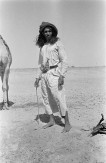
Three Views of Oman
Back
Three Views of Oman
-

Salim bin Kabina, Ramlat al-Wahiba. Wilfred Thesiger, 1949
-
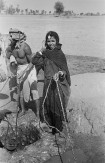
Girl of the Wahiba at a well, Wadi Halfayn. Wilfred Thesiger, 1949
-

Main gate, Muttrah. Charles Butt, 1967
-

Beaching a cargo ferry, Salalah. Charles Butt, 1969
-
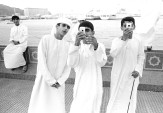
Corniche, Muttrah. Edward Grazda, 2005
-
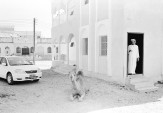
Dalkut, Dhofar. Edward Grazda, 2006
-
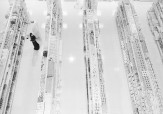
Shopping mall, Ibri. Edward Grazda, 2005
Selections from the Three Views of Oman exhibition, on display in the Arthur A. Houghton Gallery from March 11 - April 25.




